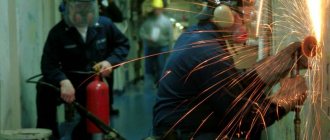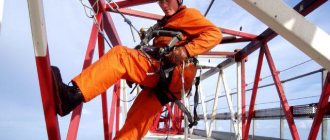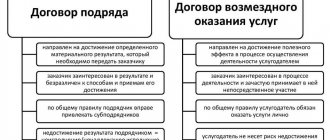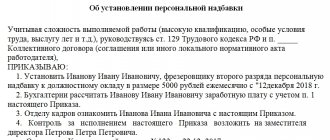There are high-risk jobs that not all citizens are allowed to perform. They differ in working conditions, imply compensation payments and a certain procedure for obtaining access and preparing for the work process. The legislation of the Russian Federation has developed a special list of industries and professions that are included in the list of dangerous ones. The employer has great responsibility when recruiting staff and organizing the work process. There is always a risk of injury and danger to the lives of production employees.
Types of work and professions related to high-risk work
- Steeple climbers and at heights.
- In confined spaces (tanks, compartments, boxes, pipelines).
- In wells, pits, trenches and pits more than 2 m deep.
- Production and use of glass wool, fiberglass, slag wool and products made from them.
- Logging, transportation and rafting of timber.
- Installation and dismantling of buildings, structures and their parts, scaffolding, scaffolding, canopies, formwork.
- Installation, adjustment, maintenance, repair and dismantling of lifting machines and mechanisms, conveyors, technological and machine equipment, electrical installations and power lines.
- Installation and dismantling of power lines, building structures and technological equipment using helicopters.
- Removing stones and strengthening slopes of mountain slopes, canyons, gorges and ravines.
- Repair and adjustment of hydraulic and pneumatic equipment and tools.
- Checking, straightening and installing abrasive stones on equipment and tools.
- Construction and maintenance of ice crossings and roads, fords and ferry crossings.
- Chemical and fire-resistant protection of wood and wooden products.
- Operation, maintenance and repair of intra-shop rail and non-rail transport.
- Operation, maintenance and repair of technical fleet watercraft and hydromechanization equipment.
- Preparation and use of cold and hot bitumen mastics.
- Batch preparation and glass melting.
- Manufacturing of products from molten glass.
- Storage, transshipment and transportation of explosive materials, gas cylinders, caustic and toxic substances, and other dangerous goods.
- Electric heating of concrete.
- Manufacturing and testing of slings.
- In underground mines.
- In security zones of overhead lines.
- In areas exposed to high frequency currents, electrostatic electricity, areas of increased electric or electromagnetic field strength, as well as work using lasers.
- Operation, maintenance and repair of pipelines and pressure vessels.
- Installation of metal coatings.
- Application of concrete, mortars, insulating and lining materials using the spraying and spraying method.
- Coating and heat treatment of metals.
- Work using open fire.
- Work using hand-held electric and pneumatic machines and tools.
- Work using pitches, epoxy resins and other chemicals with toxic properties.
- Work with the use of acids, alkalis and other aggressive and toxic liquids and materials. Chemical cleaning of equipment.
- Work using flammable, combustible and explosive liquids and materials.
- Work involving the use of radioactive substances and sources of ionizing radiation.
- Foundry works.
- Drilling wells and boreholes.
- Driving piles.
- Cementation and chemical consolidation of soils and foundations.
- Imploding works.
- Electrical thawing of soils.
- Work in electrical installations under voltage.
Security organization procedure
High-risk work involves the presence of a dangerous zone for people. For example, dismantling buildings or working with electrical equipment and acids. Therefore, even before work is carried out, hazardous areas must be clearly identified.
These are considered:
- The area near uninsulated live parts of equipment.
- Distance up to 2 meters from unfenced height differences of 1.3 meters or more.
- Plots next to a building under construction.
- Areas near structures that are being worked on.
- Territories of movement of machines, mechanisms, equipment.
- Areas over which loads are moved by a crane.
- Territories with equipment containing toxic, radioactive, chemical, flammable, hazardous substances.
- Places that contain chemical, hazardous, highly concentrated, harmful solutions that exceed permissible levels.
To prevent persons who are not involved in the work from entering hazardous areas, fences are installed. This is reflected in the admission certificate. The limits of hazardous areas are indicated in special tables. If there are none, they are installed by those responsible for organizing the work.
Professions of workers associated with high-risk work
- Autoclave operators; workers, operators servicing pressure vessels.
- Battery workers.
- Asphalt concrete workers (asphalting workers, welders).
- Drillers.
- Bunkerers.
- Bombers.
- Divers.
- Vulcanizers.
- Generator operators of acetylene installation.
- Hydromonitors.
- Flaw detectors.
- Dosimetrists.
- Lime diggers.
- Insulators (waterproofers, thermal insulators, film insulators).
- Stokers.
- Caisson workers.
- Acid resistant.
- Coppers.
- Blacksmiths.
- Boiler cleaners.
- Stokers:
- a) when burning coal as fuel in low-capacity boilers - boiler room drivers (stokers);
- b) when burning fuel oil - machinists;
- c) when burning gas - operators.
- Roofers.
- Winches.
- Painters working with paints and varnishes that have toxic properties.
- Machinists (motorists, operators) of construction machines and mechanisms.
- Drivers (crane operators, mechanics, operators) of lifting machines (mechanisms) and conveyors.
- Machinists (motormen, operators) of hydromechanization equipment and technological equipment.
- Drivers (assistant drivers) of locomotives.
- Machinists (motormen, drivers, operators) of intra-shop rail and non-rail transport.
- Operators of internal combustion engines, compressor units, reloaders, steam engines and locomobiles.
- Car dumper operators, reloader operators.
- Drivers of mine hoisting machines, rock loading machines, stackers, tunneling shields, electric locomotives for haulage.
- Coppersmiths.
- Metallizers.
- Installers (structures, equipment, electrical installations, equipment, devices).
- Foundry workers.
- Lime burners.
- Fireproofers.
- Operators of pyrotechnic, electrical and pneumatic tools; gas stations.
- Haulers.
- Solderers.
- Sandblasters.
- The crew of the technical fleet.
- Explorers.
- Glaziers.
- Slingers (hooks), riggers, signalmen.
- Rock climbers, mountain climbers.
- Stem.
- Shotcrete workers.
- Pipelayers.
- Poisoners.
- Electricians.
- Electric and gas welders (gas cutters, gas cutters, kerosene cutters).
- Electrical mechanics.
- Electricians.
- Electromechanics for elevators.
- Mechanics performing gas hazardous work.
- Distributors (storekeepers) of VM warehouses.
- VM warehouse workers engaged in loading and unloading operations.
If an enterprise or organization has not specified in this List that require increased safety requirements, the head of the organization (enterprise) is given the right, in agreement with local state inspection bodies, to make appropriate additions to the List.
Personal protective equipment when performing gas hazardous work
The rules for conducting gas hazardous fire and repair work require that each performer and observer must be properly equipped to ensure protection from harmful effects. Protective suits, gloves, and hats are used. Sometimes there may be a need for helmets and gas masks. Activities underground without respiratory protection are not permitted by the labor protection service.
Personal protection
All personal protective equipment for performers must have antistatic properties in order to avoid accidents.
Gas-hazardous work must not be carried out in shoes with metal nails or horseshoes. Equipment that may produce a spark during use must not be used.
List of high-risk work for which a work permit is required
- Construction, installation and repair work using construction machines and mechanisms in the security zone of overhead power lines (OHT), utilities near or on the territory of warehouses of flammable or combustible liquids, flammable or liquefied gases, toxic, aggressive, radioactive substances.
- Excavation work in areas with pathogenic soil contamination (landfills, cattle burial grounds, cemeteries, etc.).
- Construction and installation work performed in closed containers, wells, tunnels, pits, underground workings.
- Construction and installation work carried out in areas, objects or structures that are in disrepair, or within areas with constantly operating hazardous production factors, including:
- 4.1. Work using pyrotechnic tools.
- 4.2. Work on the construction of ice, rope and pontoon crossings, fords.
- 4.3. Work on the installation of pontoons, drainage wells, laying and relaying of slurry pipelines.
- 4.4. Removing dangerous trees (rotten, dead, hanging, windfall and broken trees that can fall from the wind, push or blow).
- 4.5. Dismantling, strengthening and restoration of damaged parts, assemblies, elements of buildings and structures.
- 4.6. Work at height in the absence of scaffolding or scaffolding (except for the installation of overhead lines and communication lines).
- 4.7. Electric welding and other hot work inside and outside all tanks, as well as containers and other containers for flammable, explosive and aggressive substances.
- 4.8. Draining, cleaning, neutralization of tanks, containers and other containers containing petroleum products, acids, alkalis and other aggressive, toxic, flammable and explosive substances and mixtures.
- 4.9. Assembly, installation and repair of overhead line supports, high-rise structures, etc. using helicopters or two cranes.
- 4.10. Installation of wires and cables when crossing overhead lines through natural barriers (rivers, swamps, ravines), at intersections with other overhead lines, in the security zone of existing overhead lines, and utilities.
- 4.11. Climbing works.
- 4.12. Imploding works.
- 4.13. Work using radioactive substances.
- 4.14. Manual development of pits and trenches more than 2 m deep.
- 4.15. Work on the preparation and use of hot bitumen mastics, primers.
- 4.10. Work on the construction of metal, brick and reinforced concrete pipes.
- Construction and installation work in areas of high radiation levels.
Note. The list of works must be clarified and supplemented taking into account the specifics of the work of each organization and approved by its head.
What is gas hazardous work?
Gas hazardous activities include all tasks that are carried out in rooms and areas with a high content of hazardous substances or with the likelihood of the release of these substances. This includes all tasks related to explosive substances, flammable mixtures, and harmful vapors. Gas-hazardous work also includes activities in areas with low oxygen content (less than 20%).
Gas danger
Requirements for personnel responsible for organizing and performing high-risk work
2.1. Responsible for organizing and performing high-risk work are:
— persons issuing the permit;
— responsible work managers;
- responsible performers of work.
2.2. The following combination of duties of responsible persons is permitted:
— the person issuing the permit may also be the responsible supervisor of the work;
- the responsible work manager can be at the same time the responsible performer of the work.
2.3. The right to issue permits is granted to specialists authorized to do so by order of the head of the organization.
2.4. Person issuing the permit:
— determines the need and scope of work;
— determines the conditions for the safe performance of these works;
— monitors the implementation of measures to ensure the safety of work;
— determines the qualifications of the responsible work manager, the responsible work performer, and members of the team (link).
2.5. Specialists of the organization who have passed a test of knowledge of labor safety rules and regulations and these Instructions should be appointed as responsible work managers.
When performing high-risk work at facilities remote from the enterprise by small teams (links), the responsible manager-performer of the work, if necessary, by order of the head of the organization, can appoint a foreman (link), who has undergone appropriate training and testing of knowledge of the rules and regulations on labor protection and this Instruction with at least 3 years of work experience and a qualification of at least fourth category.
2.6. The responsible work manager is responsible for the completeness and accurate implementation of the safety measures specified in the work permit, the qualifications of the responsible performer of the work and the members of the team (link) included in the work permit, as well as for the admission of performers to the work site.
2.7. Superintendents, foremen, foremen (team leaders) who have undergone training and knowledge testing of safety rules, fire safety rules and these Instructions can be appointed as responsible performers of work.
2.8. The responsible performer of the work is responsible for the safe performance of work, compliance by team members (link) with the safety measures specified in the work permit, the mandatory use of personal protective equipment, and production and technological discipline.
2.9. From the moment a team (unit) is admitted to high-risk work, the responsible performer of the work must be at the workplace and constantly supervise the work of the members of the team (unit) and their implementation of safety measures.
The responsible performer of the work has no right to leave the workplace. If such a need arises, he must be replaced by the responsible work manager. If replacement is not possible, work must be stopped and workers must be removed from the danger zone by the responsible person (manager).
2.10. When performing high-risk work, the team (link) must consist of at least two people, including the responsible performer of the work.
Members of the team (link) are required to comply with the safety measures provided for in the work permit, as well as oral instructions from the responsible manager and the responsible performer of work received upon admission to work or during the work process.
2.11. Personnel of the organization supervising work using cranes, drilling and crane rigs, excavators, bulldozers, etc. in the security zone of an existing power line (electrical installation), must have at least the 4th electrical safety group.
2.12. Before performing work on the territory of an operating enterprise, the person issuing the permit, the responsible work manager, the responsible work performer are required to study the sections of legislative and regulatory acts regarding the work performed, and undergo an additional test of knowledge on labor protection in the organization’s commission with the participation of a representative of the enterprise. Additional knowledge testing is carried out in the manner established by the regulations in force at the enterprise (in the industry). The results of testing knowledge on labor protection are documented in a protocol in 2 copies, stored in the organization and at the enterprise, as well as with an entry in the certificate for the right to carry out work.
2.13. Foreman, team leaders, workers (performers of work) who are allowed to perform high-risk work on the territory of an operating enterprise must receive targeted instruction before admission with the involvement of responsible employees of the enterprise on whose territory the work is to be performed.
2.14. Work performers are responsible for implementing the safety measures specified in the labor protection instructions when conducting targeted training; for the exact fulfillment of the instructions of the responsible manager and the responsible performer of the work; mandatory use of personal protective equipment, production and technological discipline.
What kind of work is dangerous?
You can understand that a job belongs to the list of high-risk activities by the following signs:
- objects and tools are used, the use of which poses a health risk;
- production processes create a danger to the life and health of workers involved in them;
- the work environment is highly hazardous;
- To perform work, the relevant rules establish a requirement for preliminary training and testing of workers’ knowledge on labor protection issues;
- The production process requires the implementation of special technical and organizational safety measures.
To manage employees performing high-risk work, their managers are required to undergo training and knowledge testing on labor protection.
The procedure for registration and issuance of work permits
3.1. The work permit is issued for the period necessary to complete the specified amount of work.
In case of failure to complete the work within the time specified in the work permit or changes in the conditions of work, the work is stopped, the work permit is closed, and the resumption of work is permitted only after the issuance of a new work permit.
3.2. For each team (link) involved in high-risk work, a permit must be issued in 2 copies (one is kept by the person who issued the permit, the other is issued to the responsible work manager).
The permit form must be filled out clearly, specifically and accurately, in accordance with procedure (Appendix 4). Text corrections are not allowed.
3.3. When performing work on the territory of an operating enterprise, the person issuing the permit from the organization, taking into account existing or likely to arise hazards (constantly and potentially dangerous production factors), as well as in accordance with the measures specified in the permit certificate, issues a permit in 3 copies (the third a copy is issued to the responsible person of the operating enterprise), having agreed on safety measures and the procedure for carrying out work with the responsible person of the operating enterprise (workshop, site).
3.4. To carry out work in the security zone of power lines, communications, and other utilities, the organization is obliged to submit an application to the enterprise operating these structures, indicating the type, nature, location, start and end time of the work, as well as a list of responsible managers, responsible performers of the work and persons, having the right to issue permits indicating surnames, initials, positions and electrical safety groups and obtain written permission to carry out work.
3.5. The work permit for work in the security zone of an overhead power line, communications, and other utilities must be approved by the head (chief engineer, technical director) of the organization and signed by the person responsible for the operation of the line on the part of the owner.
In units performing the specified work and located at a distance of more than 50 km from their organizations, the work permit is approved by the head of the unit or another responsible manager (specialist) who has undergone appropriate training and is authorized to do so by order of the organization.
3.6. The number of permits issued simultaneously to one responsible work manager is determined by the person issuing the permit, based on the physical ability of the responsible manager to perform his duties.
At the same time, the responsible work manager should not have more than three open work permits at the same time.
3.7. The responsible performer of the work may be issued only one permit.
3.8. At the end of the shift, as well as during breaks in work on holidays and days of rest, the responsible performer of the work is obliged to transfer the work permit to the responsible work manager for storage.
When resuming work, the responsible manager is obliged to personally verify that the conditions of their production have not changed, and only after that return the work permit to the responsible performer of the work. Resumption of work without a work permit is prohibited.
3.9. The shelf life of a closed permit is 30 days.
3.10. The issuance and return of permits are registered in the logbook for the issuance of permits for high-risk work or combined work (Appendix 5). The magazine must be numbered, laced and sealed with the organization's seal.
Magazines, blank forms and closed permit orders must be kept by the person issuing them.
The magazine's shelf life is 6 months. since the last entry.
3.11. The responsible work manager does not have the right to accept an authorization order to authorize a team (unit) to work if the nature and conditions of the work and safety measures are not reflected in the authorization order to the required extent or do not comply with safety rules. He is not responsible for refusal to accept the work permit and admit personnel in these cases.
The responsible performer of the work does not have the right to receive a permit and begin the work of the team (unit) if the nature and conditions of the work, safety measures do not comply with the current rules and instructions on labor safety or are not reflected in the permit to the required extent. He is not responsible for refusal to obtain a work permit and begin work.
Validity, renewal and storage
The average duration of an order is 15 days. But this figure may vary depending on the nature of the work being carried out.
To carry out a number of consecutive actions of the same type, a permit for 1 day is issued for each of them. If we are talking about hot work, then the action of the outfit is limited to one shift.
Important! You can extend the validity of the document only once for another 15 calendar days. These powers are vested in the person who issued the previous order.
After completion of the work, the document must be stored at the enterprise for at least thirty days after its expiration. In the event of an accident at work during work, this documentation must be attached to the incident investigation materials. The shelf life will be extended by 45 years.
Features of the organization and safe production of combined work
5.1. Combined construction and installation work is considered to be work that is carried out at one site, facility (building) simultaneously by several organizations (divisions), with their work areas touching or overlapping one another.
5.2. Responsibility for the safe organization of combined work throughout the entire construction and installation complex rests with the managers of the general contracting organization.
5.3. The head of the general contracting organization is obliged to allocate and by his order assign sections of the entire construction territory, as well as all objects, buildings, structures or parts thereof under construction to the divisions of his organization.
The transfer of sections of the construction territory, parts of buildings, structures or individual objects to subcontracting organizations for the performance of construction and installation work is formalized by a bilateral act between the general contractor and each subcontractor for the period of performance of the specified work.
The specified divisions and organizations in the areas, territories, buildings and structures assigned to them are charged with the responsibility of performing the functions of a general contractor for the organization and safe execution of construction and installation work, as well as monitoring their implementation.
Note. A section of the territory may include hazardous areas, roads, underground and other communications.
5.4. The heads of organizations performing the functions of a general contractor at the sites (facilities) assigned to them are required to develop and agree with subcontractors on a schedule for the production of combined work, occupational health and fire safety measures, mandatory for all organizations carrying out work on this site.
5.5. Responsibility for the safe organization of combined work at the site (with the right to issue permits for these works) rests with:
5.5.1. From the beginning of construction until the transfer of the facility under a bilateral act to a subcontractor - to the heads of departments of the general contractor.
5.5.2. After signing a bilateral act of acceptance of an object or its part (territory) for work to be performed by a subcontractor - to the head of the subcontractor.
A subcontractor performs the function of a general contractor only in relation to its divisions or organizations engaged by it under separate contracts.
5.5.3. After completion of the work and transfer of the facility by the general contractor for temporary or permanent operation - to the responsible person of the operating organization, appointed by order (written order).
5.6. At sites located at a distance of more than 50 km from the location of the organization, it is permitted to issue permits for the performance of combined work and their approval by the head of the unit performing the functions of a contractor at this site, provided that he is appointed by order of the organization to be responsible for the safe performance of work at this site object.
At the same time, general control over the work permit system and responsibility for the safe organization of combined work rests with the heads of the organizations to which the named divisions are subordinate.
Responsibility
If we talk about responsibility for organizing combined work, then it rests mainly with the head of the general contracting organization. In any work involving hazardous factors, there is a person responsible for organizing safety during the performance of work functions by employees.
These are team leaders, persons issuing work permits (if the unit/team employee is innocent of violating production safety), department heads, persons who have not complied with the work safety requirements.
Thus, any production associated with the implementation of dangerous labor functions must be regulated in detail not only by legislative acts, but also by local acts of enterprise management, as well as work permits.








